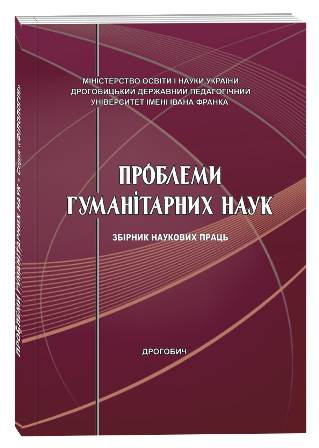ADJECTIVE → ADVERB JUST? (CORPUS-BASED STUDIES OF THE GRAMMATICALIZATION PROCESS IN ENGLISH)
DOI:
https://doi.org/10.24919/2522-4565.2023.58.1Keywords:
adverb, grammaticalization, focusing adverbs, adjective, particularizer adverb, exclusive adverbAbstract
The article presents the analysis of the focusing adverb (FA) just standing in English through the prism of the theory of grammaticalization. It studies the main models of adverbs formation from Old to Early Modern English, represented by modern affixed and non-affixed forms. It proposes a general partition of FAs into restrictives (exclusives, particularizers) and additives (scalar, non-scalar). It has been established that the adverb just in Present-Day English simultaneously pertains to two subclasses of focusing adverbs: exclusives and particularizers. It has been determined that in Middle English the lexeme just functions as a noun, a verb, an adverb and an adjective, with the meaning of the latter prevailing in the texts of the XIV–XV centuries. It has been proven that the restrictive particularizer just originates from the corresponding adjective with Latin/French base with its first fixation in the records dating back to 1417. The paper has traced the dynamics of the meaning extension of the lexeme in the Early Modern English language, determining the frequency of its usage as an adverb in certain historical periods: 1500–1550s, 1550–1600s, 1600–1690s. It has been quantitatively confirmed that the restrictive meaning of the adverb starts dominating in the texts of 1500–1550s, and the exclusive sense is first registered in the records of 1600–1690s. The grammaticalization scheme of FA just can be determined as follows: Middle English adjective → Early Modern English adverb of manner → Early Modern English particularizing FA → Early Modern English exclusive FA. From a semantic point of view, this process is related to the dual interpretation of adverbial meanings (1st stage of grammaticalization), which at the second stage of grammaticalization causes a metaphorical transfer of the unit meaning and contributes to its new contextual usage.
References
Andrushenko O. The Scope of just : Evidence from Information-Structure Annotation in Diachronic English Corpora. Proceedings of the 6th International Conference on Computational Linguistics and Intelligent Systems (COLINS 2022), May 12–13, 2022. Gliwice, Poland, 2022. P. 677–696. URL : https://ceur-ws.
org/Vol-3171/paper51.pdf.
Andrushenko O. Exclusive Adverb in Old English? A Corpus-Based Study of an(e). Вісник Житомирського державного університету імені Івана Франка. Філологічні науки. 2022b. Вип. 97. № 2. С. 30–44.
Andrushenko O. Dynamics of Focusing Particularizers in English : Just the Interplay of Internal and External Factors. The 45th Annual Meeting of the German Linguistic Society (DGfS 2023). Cologne : University of Cologne, 2023a. URL : https://dgfs2023.uni-koeln.de/sites/dgfs2023/Booklet/AG_Beschreibungenund-Abstracts /Description-Abstracts-AG03.pdf.
Andrushenko O. Information Structural Analysis of Old English Focusing Adverb ealswa. Актуальні проблеми мовознавства та лінгвометодики в умовах війни в Україні : Збірник матеріалів Всеукраїнської науково-практичної інтернет-конференції (з міжнародною участю) / За ред. К. Я. Климової. Житомир : Поліський національний університет, 2023b. C. 29–33.
Andrushenko O. Particularizing Focus Markers in Old English : Just a Case of Adverb Polysemy? Lege Artis. Language Yesterday, Today, Tomorrow. 2023. Vol. 8. Issue 2. P. 2–14.
Atherton M. Complete Old English : A Comprehensive Guide to Reading and Understanding Old English with Original Texts. London : Teach Yourself, 2019. 325 p.
Brinton L. The Evolution of Pragmatic Markers in English. Journal of Linguistics. 2017. Vol. 55. Issue 2. P. 449–453.
Chomsky N. The Minimalist Program. Cambridge Mass : MIT Press, 1995. 426 p.
Cohen G. How Did the English Word just Acquire its Different Meanings? Chicago Linguistic Society (CLS). 1969. Vol. 5. P. 25–29.



